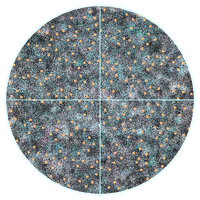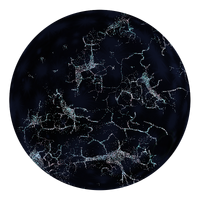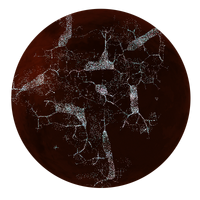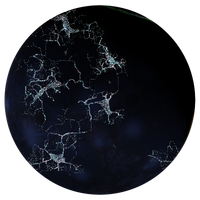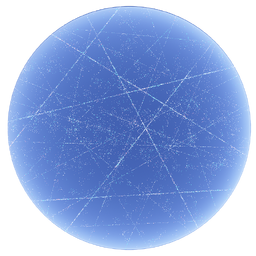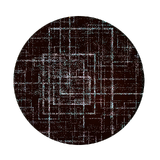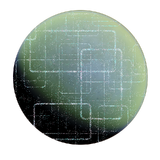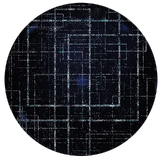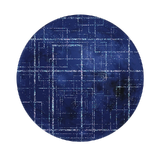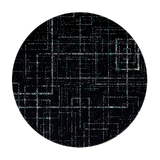“The Nivenian Empire is certainly one of our best JClients and JFriends! We understand each other very well, and our JTrade Route will make us prosper!”
The Nivenian Empire is an empire in the Cyrannus Galaxy notable for its compactness. While the Nivenian Empire has no faster than light travel capabilities, and thus only holds two systems, it has advanced megastructural infrastructure allowing it to support an otherwise unreasonable number of inhabitants.
The largest trade organization of the Nivenian Empire, the Nivenian Trading Organization for Commercial Benefits (NTOCB), is currently boycotting all participants in the New Spodia Wars.
System
The system itself contains a close DB3.3/L2.4 binary pair less than two million kilometers apart, and has a M9.9V star orbiting 460 AU away. 13 planets orbit the inner pair, with the last two bound together gravitationally as a double planet. The red dwarf has 5 planets orbiting it, all of them frozen and inhospitable. The fifth planet from the first binary, Nivenia Prime, is habitable, being about 79% of the diameter and 51% of the mass of Earth. It has a gravity of 7.9938 m/sec^2. Unfortunately for non-Nivenians, the accretion disc of the primary makes most of the system too radiation-blasted to support life that had not evolved there for long-term occupation (short-term visits are fine). The location of the Nivenia System is shown below the infobox.
Numerous changes have taken place in the system in the last few centuries. First, a significant portion of the light from both stars has been blocked by ringworlds. Second, several of the formerly icy and inhospitable worlds have warmed substantially due to waste heat.
While another system, Paulo Fluctus Beta, has recently been colonized, its population is currently only 60 million.
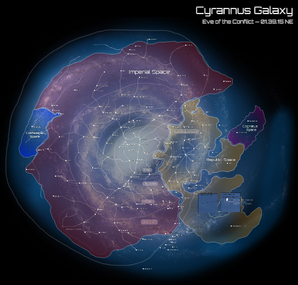
Government
Main page: Nivenian Empire/Government
The government of the Nivenian empire is a technocratic dictatorship, with an election being held when the current ruler dies. Eligible voters include accomplished scholars, scientists, and engineers, and those with very high intelligence. High-ranking military officers are allowed to vote as well, but this is an honor given only to the most prestigious generals. Typically around 0.0025% of the population is eligible to vote, and voter turnout for those eligible is usually around 81%. A candidate is usually nominated by the previous ruler before their death, and anyone one administrative level below the ruler can run. The title of the ruler is Chief Executive Coordinator. Governors are called ringworld or planetary coordinators, depending upon their domain. Other official titles one level below Chief Executive Coordinator include Research and Development Director, Executive Defense Minister, Treasurer, Secretary of Industrial Improvement, and Secretary of Agricultural Productivity, in decreasing order of political clout.
The government, upon close inspection, is more similar to a confederacy than anything else. The Chief Executive Coordinator's government's main function is to facilitate trade between different sections of the Nivenian Empire, while maintaining a certain minimum of law and order. Individual provinces and colonial provinces have a lot of power locally, so the vast majority of legislation is preformed by provincial, local, municipal, and sub-municipal government. The main methods at the Imperial government's disposal of keeping provinces in line are provincial tariffs and the Imperial Navy, in the order of increasing escalation. The Nivenian Government enacts a flat 1.5 Credit/(Nivenian*day) tax rate, charged to provincial governments instead of to civilians.
Habitable Objects
The Nivenian Empire mainly uses unorthodox methods to house population. A comprehensive list of the habitats in the Nivenian Empire, and their populations can be found here.
Ringworlds
The building block of the Nivenian Empire is the Niven ring, or ringworld, a band encircling either the white dwarf or the red dwarf. Typically 25 meters of dirt and stone are on the surface of a ringworld, with 200 meters of structural material below that. For a white dwarf-based ringworld, almost seven kilometers of more structural material sit below the ringworld proper, suspended from each other by neodymium magnets. The ringworld proper spins at 593 km/s to generate 8.00 m/s^2 of gravity, while the bulk structural material is non-rotating so that the stellar gravity can be used to hold the ringworld proper in place (if this was not there, the ringworld proper would be torn to shreds by its own centrifugal tension). The material itself is composed of 90% poly(p-phenylene-2,6-benzobisoxazole) and 10% 6061-T6 Al-Mg-Si alloy. Carbon dioxide lasers protect the rings from meteorites and muonic fusion thrusters provide stability assist systems. Ringworlds based around the red dwarf have less bulk material as the gravity is stronger at the habitable zone. Note: the white dwarf has an accretion disk and is fusing the material that lands on its surface due to the extreme gravity, leading to a luminosity only an order of magnitude below sol.
The ringworlds orbiting the M9.9V-type secondary were the first ones built, 930,000 kilometers in radius and 12,700 kilometers wide. They were built with agriculture in mind, are 75% land and 25% water, and have the land capacity for 6.7 trillion Nivenians to farm conventionally on each one. Recently, though, a decision to cover these partly in greenhouses has resulted in a tenfold population capacity increase. These ringworlds now have a population capacity of 67 trillion each, with a combined population of 6,459 trillion. The ringworlds around the secondary are actually one political unit, as they each have a (relatively, 64 trillion is no laughing matter) small population on their own, but have a large population and strong economy when operating together.
The ringworlds orbiting the DB3.3-type primary orbit between Nivenia Prime and Nivenia Secondus, at 42,000,000 kilometers in radius and 720,000 kilometers wide. These were also built with agriculture in mind (conventional agriculture is less expensive than hydroponics), and also have 75% land and 25% water. These contain the vast majority of the population of the Nivenian Empire, with each having the land capacity for 17,129 trillion to farm conventionally on each one. 35 of these have been built so far, but only 31 are open to the public, and they are partially unoccupied, having a total population of 242,151 trillion.
Megastructure Maintenance
The maintenance of a ringworld, while still small compared to the ringworld's construction cost, is still gargantuan. The ringworlds are composed of 5 km x 5 km 90% poly(p-phenylene-2,6-benzobisoxazole)-10% 6061-T6 Al-Mg-Si plates, held in a 6061-T6 Al-Mg-Si frame. The plates can be removed if punctured, and duct tape can be used as a temporary patch. The broken plates are taken to huge stations near the ringworld's sun, and recycled using the abundant solar power into new plates, which are then used to fill the hole covered in duct tape. While each plate has a half-life of 400,000 years, this still means that, for a ringworld around the primary, 12,119 plates fail and must be replaced every day. The station orbiting the primary is thus over six thousand kilometers in diameter (The station is a ring and is spinning very slowly so that it does not crumple into a sphere.).
Ecumenopolis
Nivenia Prime is an example of a planet with everything completely maxed out. The normal difficulty for Ecumenopolises (planet-wide cities) is the removal of waste heat. The Nivenian Empire has found a way around this by just attaching giant radiators to 5% of the planet's surface, and using air conditioning (a reasonably effective method of using energy to put heat somewhere else) to heat these panels to 2800 K, effectively supporting the infrastructure to hold 15,394 trillion inhabitants. 20% of these Nivenians work simply maintaining the huge air conditioners, fusion reactors, mass transport systems, and Carbon Dioxide reprocessors needed on a planet with 15,394 trillion inhabitants. The planet itself is covered by five massive sheets of metal, each 2.5 kilometers apart, with skyscrapers in between. Air is constantly pumped upward to equalize pressures, and each cityscape has walls twice as thick as the one above it. The top layer is also covered in a cityscape, and orbital rings are accessible from here.
Aerostat Habitats
The fourth planet from the close binary, Nivenia Secondus / RSC 5649-2399-4-2271-56 A4, has much the same gravity as Nivenia Prime, making it a suitable target for colonization (never mind the fact that it is a gas giant, we have a workaround). To colonize this planet, aerostat habitats were built in the 1.5 MPa region of the atmosphere by creating giant rigid aluminum spheres, expelling all the air, leaving a perfect vacuum inside, and attaching these to the colonies in question for buoyancy. These colonies currently hold 1,937 trillion, making them a common sight in the lower atmosphere. Carbon, nitrogen, oxygen, and hydrogen can be extracted from the atmosphere, turned into poly(p-phenylene-2,6-benzobisoxazole), and shipped to construction sites.
Another 1,045 trillion make their residence in the colder gas giant B3, in similar aerostat colonies, although 1,181 trillion lived there before a devastating attack that killed hundreds of trillions (The population was 587 trillion for a short period of time before a burst of immigration). B3's industry fills much the same purpose as A4's. Interestingly enough, over twice the mass of earth has already been extracted from these gas giants to build ringworlds with.
Orbital Habitats
A system-wide empire needs a system-wide transport system. When the system-wide empire has hundreds of quadrillions of inhabitants, eighty-one cubic kilometers of compressed soda can pull tabs must be transported to recycling centers every day. When hundreds of interplanetary freighters are needed just to transport pull tabs to recycling centers, the infrastructure needed for a homogeneous free-trade economy is staggering. 57 trillion workers are needed to pilot transport ships and another 89 trillion must work as clerks, accountants, supervisors, janitors, and all of the other necessary support professions needed. Trying to manage and house this system became insane hundreds of years ago. This is why large-scale orbital habitats were created. These habitats are connected to stations in "wings." Large stations may have dozens of wings, smaller ones may just have two. The stations around Nivenia Prime and Nivenia Secondus both have over two hundred, and dozens exist with more than twenty wings. Each wing is a hexagonal aluminum rod, five kilometers wide and 800 kilometers long. Six 80 kilometer-long spokes extend every 100 kilometers from the center in a hexagonal pattern, attached to 200 kilometer-long, 60 kilometer-wide O'Neill cylinders made out of the same 90% poly(p-phenylene-2,6-benzobisoxazole) and 10% 6061-T6 Al-Mg-Si alloy structural material as the ringworlds. These are small enough not to rip themselves apart, and usually have a density between a dense suburb and a full-blown city (although limited in the latter case to 10-floor buildings due to the structural integrity of the floor). On larger stations, those with more than six wings, the wings are attached to a larger hexagon (800 kilometers on a side), usually with a spaceport on the inner side of the hexagon opposite each wing on the outside. These hexagons are stacked, with the station proper suspended in the middle. The following image illustrates this:
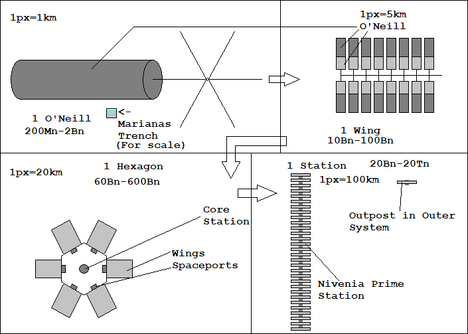
These habitats account for 287 trillion Nivenians.
Two other habitat-based provinces exist, one around the planet A6, and one just outside of the orbit of A6. These provinces have more independence than other provinces in the Nivenian Empire due to their status as swarms of detached pairs of O'Neill cylinders. The swarm around A6 is focused on utilizing the material inside the smaller moons of A6, and the other is a very thin Dyson swarm focused on scientific and legal pursuits. Both of these provinces have noticibly different cultures than the Nivenian Empire Proper, but still pay Nivenian taxes and obey Nivenian laws. The swarm around A6 has a population of 1,349 trillion and the partial Dyson swarm has a population of 8,722 trillion.
Mining Colonies
The Nivenian Empire has colonized many of the planets, moons, and large asteroids in their system for strip-mining. The materials from these planets are vitally needed to continue construction of more ringworlds and habitats. 112 trillion Nivenians live and work on conventionally inhabited planetary colonies, and 291 trillion live and work in other colonies and mining outposts (and there is B5.1, which is an exception as it holds 508 trillion). Notable mining colonies include A11, A12, A12.1, and B4, with smaller bases on dozens of small planets, moons, and large asteroids. Nivenia Prime, A11, A12, A12.1, and B4 are collectively called "the habitable five," as they have the correct gravity for Nivenians.
Biodiversity
Interestingly enough, as a product of nuclear wars, pro-efficiency legal doctrines, corporate lobbying, Nivenians complaining that species X was "smelly", and massive construction, there are currently exactly 157 species of multi-cellular life in the Nivenian Empire. Everything else was, at some point or another, determined not to be useful, and either eradicated (particularly in the case of insects), or just not given any regard as the planet was urbanized. Most of the 157 species in question have been given names like "Lawn," "Companion Type III," or "Agriculture VIII."
There are, however, about 300 "temporary species," plants originating from other empires being grown on Nivenian soil for food exports.
Technology
Nivenian Technology is absurd to the outside viewer. Although they do have some quite powerful technologies, they are mostly confined to their own system (for various reasons) and cannot use them offensively. Another major weakness is their dependence on actinides for initiation and compact power sources.
Nuclear Fusion
The Nivenian Empire has a good grasp on two methods of nuclear fusion energy generation - the CNO process and muon-catalyzed fusion. CNO fusion reactors use QCD forcefields (see next section) to confine protium and traces of carbon to extreme pressures and temperatures to create fusion. A thermonuclear activation device is used to trigger the pressures and temperatures needed. If one of these reactors breaks, there is an absurd amount of energy inside that is usually able to be slowly vented through the top, creating quite a show for anyone within 300 kilometers.
Nuclear fusion spaceships also exist, both interplanetary and "interstellar." Interstellar is in quotes because, although nuclear fusion is no joke, single-stage fusion rockets can only achieve at most 0.15c, with even multi-stage rockets becoming ridiculously expensive beyond 0.55c. The current speed record for a fusion-propelled probe is 0.87c, though probes can get much faster using laser sail propulsion, up to 0.95c. The consensus among Nivenians is that ringworlds are much easier to make than interstellar colony fleets that take years to arrive, although this has been changing by small amounts in recent years as a completed Nicoll-Dyson beam has been built.
Muon fusion is also used for boosting thermonuclear weapons. A weapon can be installed with a "thermodynamic confinement shield" to keep the energized plasma from expanding once the bomb has exploded, and a "muonic weapon booster" to turn the energy of the fusion reaction into high-speed muons. These will interact with any hydrogen on the target, triggering more nuclear fusion. This can boost the yield of a weapon tenfold.
Laser sail propulsion
Approximately 0.1% of the sunlight of the system primary has been harnessed by Fresnel lenses and mirrors to provide a propulsion system for small probes and sometimes other stuff too (see section on R.K.M.s). These probes can reach 0.95c, but are mainly designed for short system flybys. The efficiency of the laser can be increased by bouncing the laser back and forth between a mirror on the spaceship and a mirror in orbit of the star. While the added efficiency diminishes in relativistic conditions due to redshift, almost all of the energy of the laser can be used to propel the ship. Note that these probes are extremely high-energy: a 500,000 kg probe (mostly equipment for transmissions) moving at 0.95c will have 98.19ZJ of energy, as much as 1.558 billion hirosima bombs. These probes are all designed to miss the primary by at least ten times the distance of the habitable zone, so as not to accidentally destroy any planets.
Grand Unified Theory and Quantum Chromodynamic Shields
The Nivenian Empire has developed a working Grand Unified theory that unifies the electromagnetic, weak nuclear, and strong nuclear forces. As such, they have developed generators that can create potential energy walls using the strong nuclear force. Medium-strength shields are powerful enough to stop any hadronic projectile carrying less than 180 TJ/mol quarks (This would take 10 megawatts per square meter of electricity.). These shields are only commonly available in sphere shapes, but the radius-potential energy function can be changed at will, allowing for the creation of larger, more spread-out shields to deflect kinetic projectiles. This is required since if kinetic weapons are used against most shields, the momentum will end up kicking the shield generator right out the back of the ship. These shields, while extremely powerful against most weapons, are useless against lasers, electron beams, and unconfined kugelblitz bombs. However, if the power suddenly goes out, the shields will contract almost immediately to a very small size, only pushing through whatever is inside it after the material has been compressed into a form of stabilized electron-degenerate matter.
Shields are especially useful for creating miniature fission reactors for portable power. For a given reactor, if the power gets too low, the shield shrinks, compressing the reactor and increasing criticality. If the power is too high, the shield expands, decreasing criticality. Although this is only useful with otherwise sub-critical fission power sources, it can extract every last joule of energy, leaving the reactor a tiny orb of hot, radioactive, electron-degenerate fission decay products, a perfect radioisotope thermoelectric generator for other uses. The percentage of fission energy going to the shield can be modulated to change the size and activity of the reactor.
Three geometries of shields are available, with any other geometries being confined to research in the laboratory: spherical, parabolic, and toroidal shields, in order of increasing complexity. For the spherical and toroidal shields, the strength of the shield is directly proportional to the power per unit area of the shield (parabolic shields are similar, but they have shield strength proportional to the square of the distance to the focus on any point on the shield, instead of constant strength everywhere.).
These shields can only be created with an exotic form of matter with a property called color superconductivity. This form of matter takes the form of an enormous baryon with has similar properties to a nucleus. Although this "nucleus" is one particle composed of a huge number of up and down quarks, the masses range from 163 amu (with charge +39) to 609 amu (with charge +163). These have to be created through the use of cyclotrons to create extremely high-mass nuclei (although smaller stable quark matter nuclei can exist, they are not energetically favored), usually around 350 amu, followed by bombardment with neutrons until the wanted mass is achieved. The standardized mass for most applications is the Plutonium-366 quark matter nucleus.
Integrated Circuits and Artificial Intelligence
Although extremely primitive by most species' standards, computerized systems are an important part of Nivenian life. Nivenians have recently upgraded their transistors from 250nm to 200nm architecture, now on par with late 20th century humanity. Despite this, they do have a few artificial intelligences (2 TW+, 200 EHz, 40 city block ones with gigantic radiators to dissipate the huge amounts of waste heat created) with capabilities similar to Richard Feynman. These are estimated to improve empire-wide scientific progress by ~32%.
However, these computers are completely deterministic, and thus are not truly sentient. They can contribute greatly to scientific progress, but they cannot actually experience the world.
Instability
As the Nivenian race has an extremely high radiation tolerance, much of their technology is VERY radioactive and misuse could result in explosion (in the case of most nuclear technology), or implosion to electron degenerate matter (in the case of QCD shields). Stealing most of their technology is nigh-impossible and could result in you losing a finger. Or a continent.
The Brute Force Method
A staple of Nivenian technology and culture is the brute force method: "If brute force does not work, you are not using enough of it."
Hyperwave relays
While the Nivenian Empire does not have access to hyperspace travel, they do have access to hyperspace communications. This is usually done through transmitters purchased from the New Cyrannian Republic Embassy on A11, but only the largest corporations and the imperial government have access to them, as they cost petacredits in the Nivenian Empire. Even so, two are onboard the STL expeditions to the Caeruleo and Paulo Fluctus Beta systems, as they have a lot of resources and easy communication is worth the expense. Signals to pre-FTL races must be conducted through radio, though.
Technologies in development
Currently, the Nivenian Empire is working on ways to create and feed kugelblitzes to power kugelblitz related technology such as total mass-energy conversion reactors, kugelblitz drive to easily accelerate to 60% lightspeed, and confined kugelblitz bombs for armor- and shield-piercing capabilities.
Economy
The Nivenian empire's economy is a quite large one (hundreds of quadrillions of workers are quite useful). The population can be split into 5 main strata: The capitalists, the management, the specialists, the workers, and the indentured servants. In the system, citizens generally separate out in the three middle strata by intelligence. Indentured servitude is usually the punishment for crimes (this is so the government can arrest people, force them to do work, and contract them out to fund itself while not charging taxes to law-abiding citizens), and is temporary. The capitalists are very few in number, but they own the means of production, and are very politically influential.
The currency unit in the Nivenian Empire is the credit. A credit looks like a slip of plastic that says "one credit," but if you have a nuclear material license you can go to the treasury and pick up a milligram of plutonium-239 in exchange for the credit. The credit currency system is directly tied to the value of plutonium, as plutonium-239 is incredibly energy-dense by volume and is crucial to most Nivenian technology. One credit is worth approximately 4 times as much as a 2020 United States dollar. Typical earnings are 1.8 to 3.5 Kilocredits per year for workers, 6.2 to 35 Kilocredits per year for specialists, 35 Kilocredits to 200 Megacredits per year for management, and anywhere between 40 Kilocredits and 10 Exacredits per year for capitalists. 65 percent of the population are workers, 30 percent are specialists, 4.5 percent are management, and 0.5 percent are capitalists. Moving from one stratum to another typically involves either starting your own business or climbing the corporate ladder for upward mobility, or making one or more important Nivenians mad for downward mobility.
The main products of the Nivenian Empire are food and energy. The food is produced by the surplus of farming areas on the ringworlds, and the energy by nuclear fusion and a partial Dyson swarm.
Unfortunately the Nivenian Empire is currently experiencing a large recession due to the recent bombing of B3.
The Megastructural Construction Corporation
Main page: The Megastructural Construction Corporation
One of the largest and most influential corporations on Nivenia Prime is the Megastructural Construction Corporation (MCC). The MCC specializes in energy, land, mining, and construction, and is quite proficient in all three of those things. They are also estimated to control 41.3% of the Nivenian Empire's economic strength. They are a privately held corporation, and have been held by the same family, the Edwards, for almost 500 years. The MCC built all of the ringworlds and habitats, owns all of the fusion reactors, and has mining sites all over the system to extract more raw materials from noncolonizable planets. The MCC typically builds more ringworlds whenever the cost of bulk land rises to more than 8 Kilocredits per hectare. The Edwards family is quite influential, and has continuously held positions as advisors for over 150 years, and more and more they act as a shadow government. The Edwards generally spend their vast profits on the advancement of science for the MCC and the Nivenian Empire.
MegaSuperUltraCorp
Main page: MegaSuperUltraCorp
MegaSuperUltraCorp is a gigantic corporation comprising 17.2% of the Nivenian Empire's economic strength. They are a publicly held corporation formed from the mergers of several large agricultural conglomerates, and as such specialize in agriculture. They are planning to standardize many name-brands of food, both within the Nivenian Empire and for export to the New Cyrannian Republic and JSector. They are not in direct competition with the Megastructural Construction Corporation, but tensions still exist as a land-acquisition monopsony would be disastrous for the Megastructural Construction Corporation's profit margins.
History
The history of the Nivenian empire is actually quite long, but even worse, there is no clear division between when they were a planetary civilization and now, when they are capable of defending themselves from interstellar attack. For a detailed account of the history of the Nivenian Empire before First Contact, see here. For a detailed account of the history of the Nivenian Empire between first contact and the star of the Nivenian-Thadian War of Annexation, see here. For Nivenian History during and after the Nivenian-Thadian War of Annexation, see here.
Culture
The Nivenian Empire's culture varies with the particular region of the object that a citizen inhabits, and some sections are radically different than others, but there are some general trends that stay the same, no matter of location. More information about the culture of the Nivenian Empire can be found here.
Astrography
The Nivenian Empire only has control over one star system, and claims everything within one light-year. However, only the region of space within about 3500 AU of the system is defendable. Outside of the system proper is the interstellar cometary cloud, starting approximately 800 AU away from the center of the binary. This cloud, stretching into the void, is home to millions, possibly billions of breakaway colonies that vie for independence and autonomy. While these colonies do not attack, only defend, rumors of a larger empire inhabiting a rouge planet are rampant within the empire. While speeds of 0.09 c are easily attainable using fusion, the need for weapons and life support on most ships limit their maximum speed to 0.055 c. Faster military vessels designed for speed can reach 0.085 c, but anything beyond about a year away cannot be easily patrolled, and anything outside the system proper cannot be patrolled well, allowing for "pocket colonies" of thousands to millions to spring up on long-period comets, powered by nuclear fusion and apt at recycling so as to render imports unnecessary.
Neighbors include the Thadus 0037 faction (called the Democratic State of New Home by its inhabitants) at Thadus 0037, 1.52 light-years away, and the New Cyrannian Republic, approximately 138.7 light-years away.
Notable planets
The habitable five
Gas giants
Smaller inhabited planets
Military
The Nivenian military currently employs 1.13% of the population of the empire, with 0.07% of the population, or 188 trillion Nivenians serving on active duty. This makes it very powerful, but only within the Nivenia system. As the Nivenian Empire has no FTL, the scope of the military beyond the system is limited to R.K.M.s (Relativistic Kinetic Missiles) and, within very limited range, ships propelled by Nicoll-Dyson laser and using magnetic fusion ramjets for slowdown. An article on the Nivenian defensive capabilities can be found here.
Relativistic Kinetic Missiles
Propelled by mirrors reflecting the light of the white dwarf primary, focused by Fresnel lenses to a tight beam, them bounced back and forth between mirrors in orbit of the star and mirrors on the back of the ship for the maximum energy efficiency. While a crust-melting missile can be accurately launched at a planet approximately every 6 hours, these missiles travel at between 80 and 90 percent the speed of light, and so cannot reach anywhere important in any reasonable length of time.
Foreign Affairs
The Nivenian Empire has recently made first contact with the ently has a mutally beneficial trade deal with them, trad, and currently has a mutally beneficial trade deal with them, trading 8 quadrillion tonnes of food for 4 trillion tonnes of refined Thorium-232 for use in breeder reactors every year.
At the beginning of 21 NE, the Nivenian Empire started trading with JCompany, and is one of their best clients. JCompany is potentially the Nivenian Empire's largest trading like to the rest of the Gigaquadrant, as it trades large volumes of goods with both the Nivenian Empire's largest companies and smaller companies which primarily sell to the public. Although more than one attempt has been made by companies in the Nivenian Empire to monopolize JCompany goods by attempting to make exclusive deals, JCompany and the Nivenian government has prevented these deals from occurring as they would inhibit the free flow of goods between the two empires.
At the beginning of 24 NE, the Nivenian Trade Organization for Commercial Benefits (a business alliance between the Megastructural Construction Corporation and MegaSuperUltraCorp) became successful in a total lock-down of trade with countries participating in the New Spodia Wars, as these wars are problematic to the economic state of the gigaquadrant and the security of economic deals in those regions.
Relations
(In decreasing order of friendliness)
- No Tariffs
“Free trade is awesome.”
 JCompany -“Our largest trading partner, JCompany products are highly recommended by 94% of their users in the Nivenian Empire. We understand each other very well, and our JTrade Route will make us prosper!”
JCompany -“Our largest trading partner, JCompany products are highly recommended by 94% of their users in the Nivenian Empire. We understand each other very well, and our JTrade Route will make us prosper!”
 New Cyrannian Republic - “Our second largest trading partner, the New Cyrannian Republic trades large quantities of actinides for a portion of our food surplus.”
New Cyrannian Republic - “Our second largest trading partner, the New Cyrannian Republic trades large quantities of actinides for a portion of our food surplus.”
 Null Empire - “We have done quite a lot of trading with the Null Empire, and their products have proven to be in high demand.”
Null Empire - “We have done quite a lot of trading with the Null Empire, and their products have proven to be in high demand.”
 Narkal Republic - “The Narkal Republic's proximity to the Nivenian Empire makes trade much easier.”
Narkal Republic - “The Narkal Republic's proximity to the Nivenian Empire makes trade much easier.”
- Possible Trading Partners
“We hope that we can form a permanent mutually beneficial trade agreement soon.”
- Economic Sanctions
“Your existence is problematic for our economy.”
 The Purity - “The NTOCB, an economic trading block containing half of our economy, has temporarily boycotted this polity.”
The Purity - “The NTOCB, an economic trading block containing half of our economy, has temporarily boycotted this polity.”
 United Republic of Grubmolians - “The NTOCB, an economic trading block containing half of our economy, has temporarily boycotted this polity.”
United Republic of Grubmolians - “The NTOCB, an economic trading block containing half of our economy, has temporarily boycotted this polity.”
 Pure Divinity of Spodia - “The NTOCB, an economic trading block containing half of our economy, has temporarily boycotted this polity.”
Pure Divinity of Spodia - “The NTOCB, an economic trading block containing half of our economy, has temporarily boycotted this polity.”
 Perphidi Assembly - “The NTOCB, an economic trading block containing half of our economy, has temporarily boycotted this polity.”
Perphidi Assembly - “The NTOCB, an economic trading block containing half of our economy, has temporarily boycotted this polity.”
 MotSE - “The NTOCB, an economic trading block containing half of our economy, has temporarily boycotted this polity.”
MotSE - “The NTOCB, an economic trading block containing half of our economy, has temporarily boycotted this polity.”
 United Corlinian Empire - “The NTOCB, an economic trading block containing half of our economy, has temporarily boycotted this polity.”
United Corlinian Empire - “The NTOCB, an economic trading block containing half of our economy, has temporarily boycotted this polity.”
 Federated Tribes of Varslan - “The NTOCB, an economic trading block containing half of our economy, has temporarily boycotted this polity.”
Federated Tribes of Varslan - “The NTOCB, an economic trading block containing half of our economy, has temporarily boycotted this polity.”
 Coalition of Seceding States - “The NTOCB, an economic trading block containing half of our economy, has temporarily boycotted this polity.”
Coalition of Seceding States - “The NTOCB, an economic trading block containing half of our economy, has temporarily boycotted this polity.”
 Pirate Consortium - “Their attacks on the Null Empire during the Second Null-Consortium war have impacted trading, casing the loss of Teracredits.”
Pirate Consortium - “Their attacks on the Null Empire during the Second Null-Consortium war have impacted trading, casing the loss of Teracredits.”
 Kalslong Raiders - “Their alliance with the Pirate Consortium in the Second Null-Consortium war has disrupted Teracredits worth of trade.”
Kalslong Raiders - “Their alliance with the Pirate Consortium in the Second Null-Consortium war has disrupted Teracredits worth of trade.”
- Open Hostilities
“Face the wrath of our rocket exhaust!”
 Thadus 0037 Faction - “We will have revenge for your unprovoked attacks on the Nivenian Empire. Your days are numbered.”
Thadus 0037 Faction - “We will have revenge for your unprovoked attacks on the Nivenian Empire. Your days are numbered.”
Quotes*
“We are at least 17.382% sure that at least 0.0029218% of us know what we are doing”
- - A mid-level scientist on Nivenia Prime
“The Nivenian Empire is certainly one of our best JClients and JFriends! We understand each other very well, and our JTrade Route will make us prosper!”
“The Nivenian Empire is authoritarian and tyrannical. Its leaders are a bunch of lazy slobs who would commit such atrocities as calling our beloved New Home Thadus 0037! They deserve extermination.”
- - The First Official of the Democratic State of New Home
*(Feel free to add more quotes.)
Trivia
- The Nivenian Empire was named after Larry Niven, author of the Ringworld series.
- The locations of the RSC 5649-2399-4-2271-56 and RS 5649-1826-8-9514108-2562 systems are switched in this universe.

